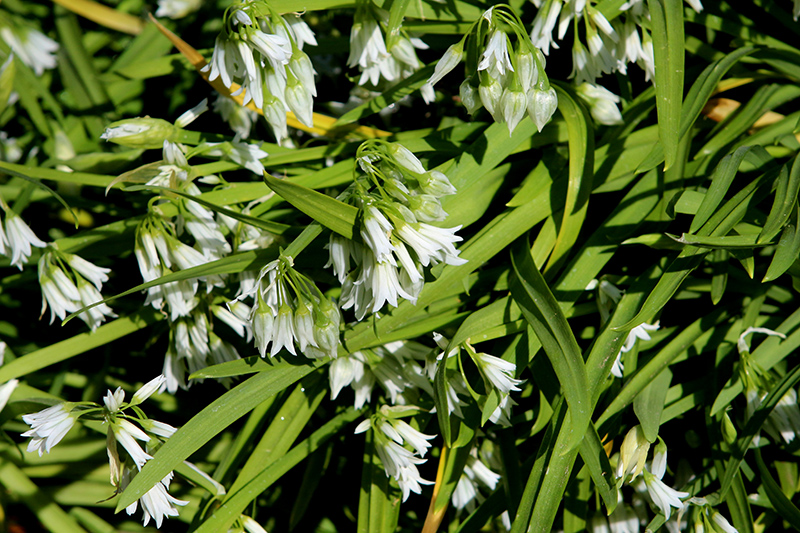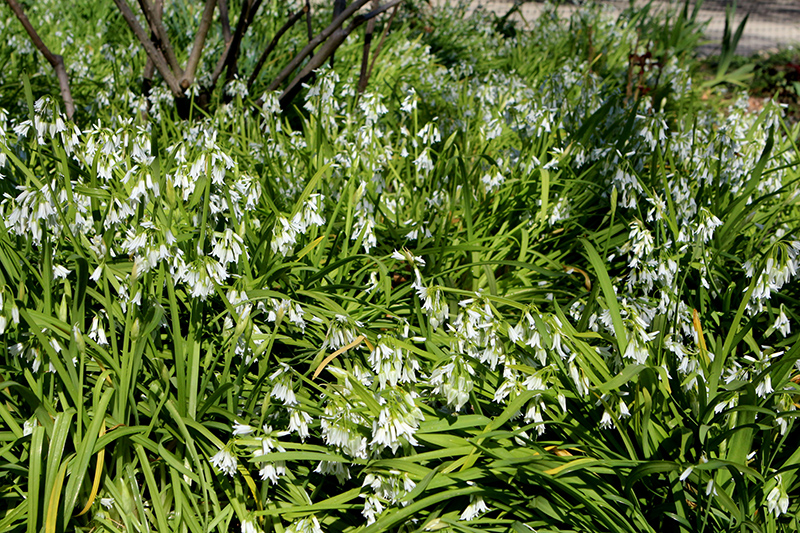Height: 12 inches
Spread: 18 inches
Sunlight:
![]()
![]()
Hardiness Zone: 8
Other Names: Three-cornered Garlic, Snowbell, Onion Weed
Description:
Edible and ornamental, this selection is great for kitchen and herb gardens, containers and window boxes; clusters of tall grass like foliage with dainty white flowers are delicious and zesty; a lovely addition to salads, sauces, or dried for seasonings
Edible Qualities
Three-cornered Leek is a perennial herb that is commonly grown for its edible qualities, although it does have ornamental merits as well. The entire above-ground parts of the plant are edible, and can be harvested at any time in the season. The edible parts have a zesty taste and a pleasant fragrance.
The plant is most often used in the following ways:
- Fresh Eating
- Eating When Cooked/Prepared
- Cooking
- Baking
- Drying
Features & Attributes
Three-cornered Leek has masses of beautiful lightly-scented nodding white bell-shaped flowers at the ends of the stems from mid winter to early spring, which are most effective when planted in groupings. Its glossy grassy leaves remain green in color throughout the season.
This is a dense herbaceous perennial herb with an upright spreading habit of growth. Its medium texture blends into the garden, but can always be balanced by a couple of finer or coarser plants for an effective composition. This is a high maintenance plant that will require regular care and upkeep, and should only be pruned after flowering to avoid removing any of the current season's flowers. It is a good choice for attracting bees and butterflies to your yard, but is not particularly attractive to deer who tend to leave it alone in favor of tastier treats. Gardeners should be aware of the following characteristic(s) that may warrant special consideration;
- Invasive
- Self-Seeding
Aside from its primary use as an edible, Three-cornered Leek is sutiable for the following landscape applications;
- Rock/Alpine Gardens
- Border Edging
- General Garden Use
- Naturalizing And Woodland Gardens
- Herb Gardens
- Container Planting
Planting & Growing
Three-cornered Leek will grow to be about 12 inches tall at maturity, with a spread of 18 inches. It grows at a fast rate, and under ideal conditions can be expected to live for approximately 8 years. As an herbaceous perennial, this plant will usually die back to the crown each winter, and will regrow from the base each spring. Be careful not to disturb the crown in late winter when it may not be readily seen!
This plant is quite ornamental as well as edible, and is as much at home in a landscape or flower garden as it is in a designated herb garden. It does best in partial shade to full shade. Keep it well away from hot, dry locations that receive direct afternoon sun or which get reflected sunlight, such as against the south side of a white wall. It does best in average to evenly moist conditions, but will not tolerate standing water. It may require supplemental watering during periods of drought or extended heat. It is not particular as to soil type or pH, and is able to handle environmental salt. It is highly tolerant of urban pollution and will even thrive in inner city environments. This species is not originally from North America. It can be propagated by division.
Three-cornered Leek is a good choice for the edible garden, but it is also well-suited for use in outdoor pots and containers. It is often used as a 'filler' in the 'spiller-thriller-filler' container combination, providing a mass of flowers against which the larger thriller plants stand out. Note that when growing plants in outdoor containers and baskets, they may require more frequent waterings than they would in the yard or garden. Be aware that in our climate, this plant may be too tender to survive the winter if left outdoors in a container. Contact our experts for more information on how to protect it over the winter months.


